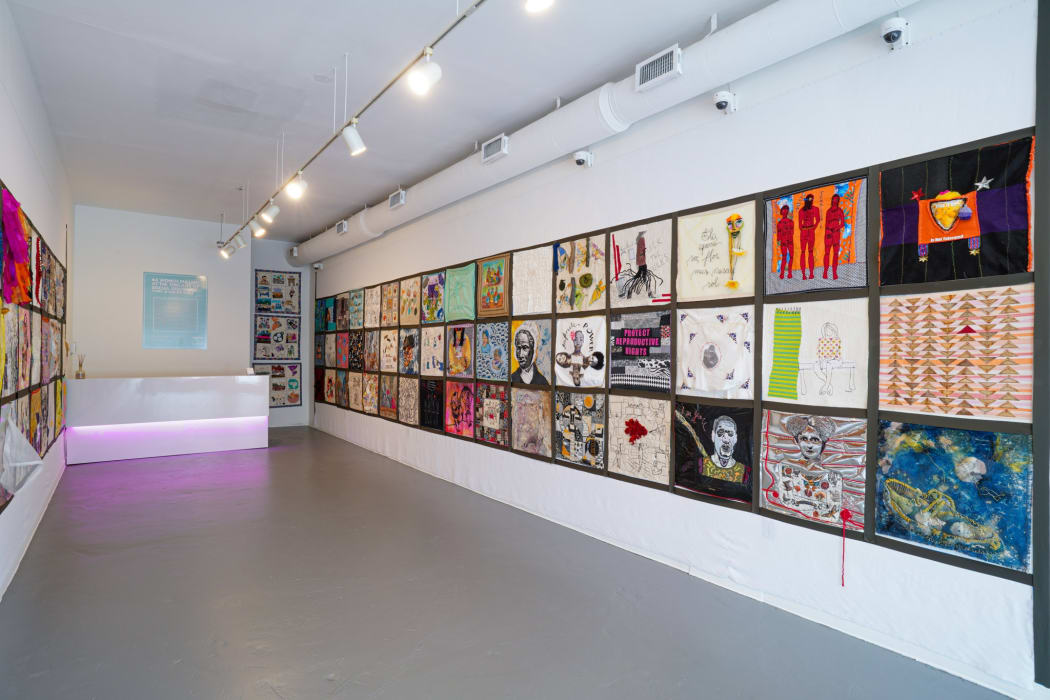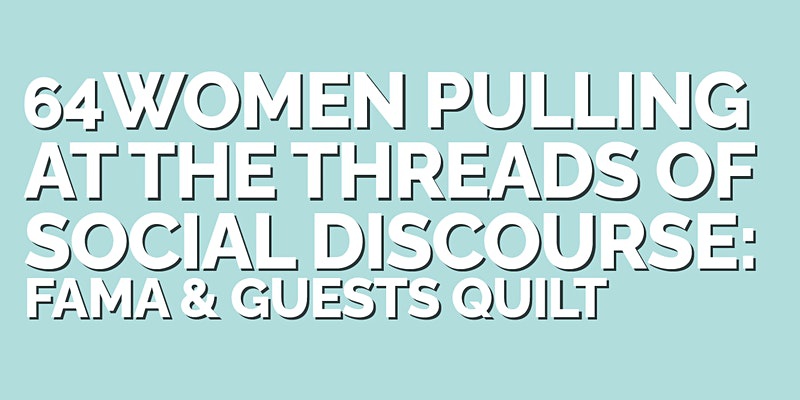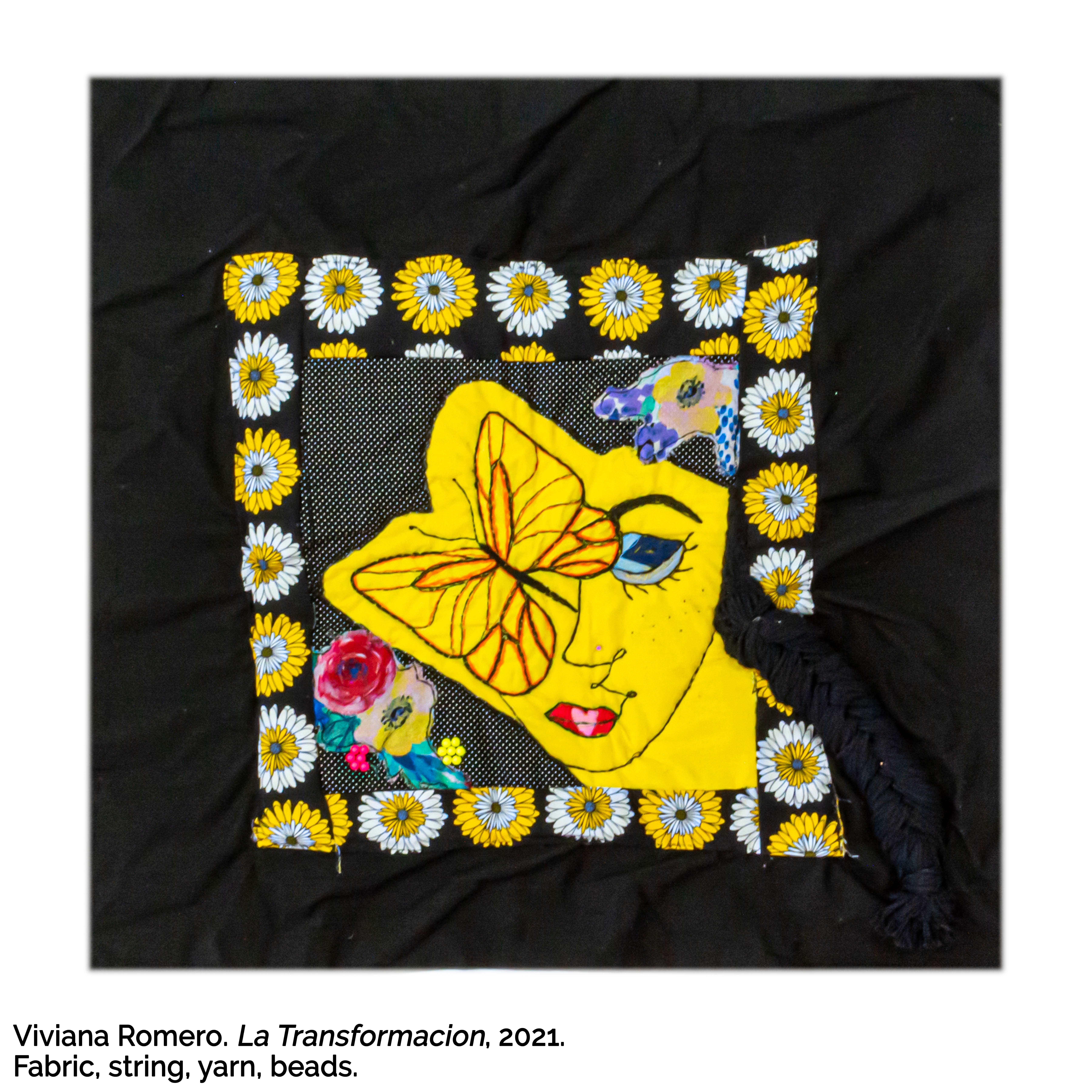

As we continue our third-annual collaboration with Fiber Artists Miami Association, the exhibition, Women Pulling at the Threads of Social Discourse, continues to reveal just how layered the original premise is at its core. If there's anything we've learned over the years, it's that fiber's adaptable quality extends beyond its material capabilites. The idea that textile art holds a dual nature in its capacity to be equally tender and jarring brings about necessary, albeit poignant, questions of its role within the context of "fine" art, as well as just how much validity our societies are willing to afford to the feminine experience.
This year's edition, which features 100 pieces displayed as massive quilt, can be explored from perspectives totaling to the same, whether they're present subconsciously or explicitly. What is certain and unquestionable is that the democratization of the fine art industry allows us, the audience, to interrogate ourselves better, and more deeply, than a run-of-the mill homogeneity allows. Whether one feels uncomfortable, affrimed, or like they've learned something they weren't expecting to, what unites both the artists and the audience is the idea that self-expression isn't something personal, and instead something that is more often than not done in the same of unity.
In typical CAMP fashion, we're interested in what the artists have to say—about their relationship with textiles, whether fiber art and fine art are as mutually exclusive as we've been lead to believe, and about their nature as artists. Read on to get to know Laetitia Adam-Rabel, Natalia Schonowski, Viviana Romero, Sandra Onetti, Maria Lino, Leslie McKinley, Laura Marsh, and Nancy Billings.
Can you tell me a little bit about your relationship with textiles?
Leslie McKinley: My maternal grandmother was a superb seamstress of the highest caliber. I was the recipient of her scraps, and I can remember creating at the age of about 5 years. But I always loved art in all forms, so working with fabric was a natural part of the total creative art experience.
Laura Marsh: My first connection to textiles was through my mother, she was kinda angry behind the sewing machine. I was always pretty fascinated by her creating clothes and fixing curtains with an inner rage. I told myself I'd never use that machine but started sewing after I made a series of hand-sewn sculptures. Sewing is really therapeutic for me. It helps me work through ideas. I could listen to the methodic motor and clomp of the machine's foot all day. I feel a connection to women who sew, and I feel I can heal my past through this art form.
Viviana Romero: My relationship with textiles started with my grandfather's second wife. They lived in Medellin, Colombia (where most my family is from). Although I lived here in Miami, I got to visit them for at least 2 weeks out of the year every now and then. She had an entire room dedicated to sewing. She could make anything! I loved to watch her work and I loved getting lost in the area where she kept all her fabrics. Something about the colors and how they felt gave me that "feel-good" feeling. She made me the romper I wore for my 6th grade school picture from a drawing I made. It was definitely exciting as a then 11 year old to see my drawing come to life through her talent.


Laetitia Adam-Rabel: I have a longstanding, and complex, relationship with textiles. My maternal grandfather was a tailor. His wife, my grandmother, was a seamstress who made wedding gowns. My mom made most of her own clothes as a young woman, and I studied fashion design in high school, at DASH (Design and Architecture Senior High), in Miami, and afterwards, in college at Parsons, in New York. I love to sew some of my and my daughter’s clothes. I love the softness that textile arts offer, especially when delving into tough topics. However, I don’t consider myself a textile artist, per se. There is so much I have to say, that one medium feels too limiting to me. In my work, I deal with different topics, and some are more digestible if spoken of in the language of textiles.
Sandra Onetti: My relationship with textiles began 40 years ago with two-needle knitting. Twenty years ago, I incorporated quilting and then, later, crochet and embroidery. First my works were utilitarian—blankets, sweaters—but then I felt a need to express myself with a more artistic form. This led me to take classes with different teachers, until I discovered that my experiences as a criminal lawyer, which includes working with people deprived of their freedom, drew me to express myself about prison confinement. Hence, my works include as concepts concerning the different forms of confinement, and as a contrast, they are made with vibrant colors.
Nancy Billings: Fabric has surrounded and directed me my whole life because I grew up with multiple family owned fabric stores in NYC. From the delicate to the extravagant, textiles always intrigued me. As a young girl I would wander in my father’s store thinking about what I could do with it all. By 10 I had my own sewing machine and was on my way creating. I believe the “what if” that I would ask myself as I touched a new piece of fabric was the catalyst for why I continued in this direction as an adult. I wanted to teach others what I loved and fulfilled that desire by teaching in middle School through college. I love the tactile nature and variety of emotions I feel when working with an assemblage of textiles. I continue to explore new ways and ideas to transmit design through textiles.
Natalia Schonowski: I started working with textiles from a very young age. My grandmother used to crochet and knit. My mom not only crocheted and knitted, but she also sewed, embroidered, did batik and felted. I got my love for art from my mom. When I started studying art at FIU, I was going to study art in the traditional sense of the word: painting and drawing. But then I took a course with Pip Brant, Fiber Based Painting, where I was introduced to fiber art in the context of contemporary art, not just as a craft.

Maria Lino: I come from a seamstress/tailor/upholsterer family. Everyone in my family knew how to sew, even my father, who was an upholsterer. His brother, my uncle, was a tailor. His sister, Tia Olga, who raised my brothers and me after our mother’s death, was a dressmaker and a tailor. I used to drive her to fabric stores to buy what she needed for the project at hand, which could range from a wedding dress to a Halloween costume. My mother had also been a dressmaker, and typically, as an immigrant, worked in garment factories both in New York City and in Miami. She also loved to knit, which she taught me when I was very young. From an early age, I’ve been surrounded by textiles (fabric, depending on the context), and made many of my clothes until I went off to college. I love textiles/fabric, particularly cotton, and often buy them without any preconceived plan for their uses. However, I don’t consider myself a fiber artist. I’m a multidisciplinary artist, and I select the medium and technique best suited for the concept I want to express. If appropriate, I manipulate and intervene textiles, including canvas, by painting, silkscreening, cutting, sewing, and writing on them.
Many of you already work within this concept of “pulling at the threads of social discourse,” whether you’re a formal textile artist or you work in a different area. Do you find that this is natural to your artistic approach, or is it natural to textile work? Could it be both?
Leslie McKinley: In the last two decades I have incorporated recycled fibers into my work, which has addressed both personal and larger social issues. It has always seemed a natural creative process. The medium (or media) an artist incorporates in a work, is a personal choice based upon the goals of the individual piece. I do not place myself into an artistic category based on any one medium. I am an artist because I create
Laura Marsh: I would say, get your head out of the sand! Fiber art has been largely mislabeled for far too long, and I think back to the criticism of the Dinner Party and for how many years it was in storage… Thankfully, the Brooklyn Museum changed the script on that and built a gallery around it and a living archive of feminist works. Textiles will always be culturally relevant since we all wear clothes and interact with fiber on a daily basis. It's the social history of fiber that's also been under-recognized, since communities have come together for centuries to make quilts and banners, telling multigenerational stories. We can empower these stories by representing them.
Laetitia Adam-Rabel: “Pulling at the threads of social discourse” is inevitable and essential to my work. As a woman artist of color, I would be remiss if I didn’t talk about uneasy, social topics in my work. The majority of my work pulls at the threads of social discourse, whether it be my textile work or work of another medium.
How do you find fulfillment in your artistic process?
Natalia Schonowski: Art is an outlet. While I’m making art, it allows my brain to process things on a subconscious level. It calms my very busy brain. It enables me to focus on what I’m doing in that moment; it forces me to be present.


What would you say to people who don’t embrace textile art as fine art and instead call it simply a “hobby” or “craft”? Can you talk about your work and how it differs from that?
Leslie McKinley: I consider all my works to be worthy of the title “art,” regardless of the materials. Textiles, paint, metal and other media all have worth and one is not “higher” or “finer” than another. What matters is the creative energy and thinking that goes into the creation of an artistic event or product.
Viviana Romero: The great debate of art vs. craft, There are pieces that clearly fit the definition of craft and pieces clearly fit the definition of art. However, I do believe there is this wonderful area in between where both meet. Kind of like an estuary where rivers and oceans collide, there is a whole array of life and beauty that coexists and belongs to this specific area. With that said, I feel this way about this beautiful artwork we collaborated with. As I created this quilt I was painting with needle and thread. It was my first time quilting and sewing and I truly enjoyed the process from beginning to end.
Sandra Onetti: I understand my work as artistic because it has a message to be read. "Craftsmanship" is repetitive, neat work that shows the perfection of the technique that the artisan acquires by reiterating his work over and over again. Textile art goes much further—it has a message, it can be political as in my case, when I talk about prison confinement, or as in the current exhibition "women pulling at the threads of social discourse," where there is a message that challenges the viewer, which does not happen with craftsmanship. Textile art also has the distinction of presenting itself with something soft, which can be touched and transmit warmth, although its concept is quite the opposite. That is why, for my piece in the exhibition, I chose the image of a padlock, which symbolizes confinement, although it also symbolizes the promise of love. I chose to make them open, so that hope can be read in them, and I accompanied them with colors, beads, embroidery and sequins to make the message more direct.


Nancy Billings: I believe United States is one of the few countries in the world which still relegates textile art to craft. For the last few years this negativity has begun to change, having recently seen many fiber/textile artworks in major art exhibits and museums around the U.S. If you travel out of our country or read art periodicals you learn that nations around the world are much more sophisticated and reverential to appreciating textile art. My art is not utilitarian. My work is meant to be displayed on walls and consists of multi-media and a variety of textiles. The action of sewing is only one of the many techniques used in creating my art. The artistic development and techniques that I use is similar whether I am using canvas (also a textile) or other fabrics.
Natalia Schnowski: Any other media can be a craft. Painting or drawing can also be a craft. I think what differs is the intention behind the process. A craft is an object you make with the sole purpose of looking pretty, but there is not much else behind it.
Why are you an artist?
Laura Marsh: My grandmother drew us with charcoal when I was little, and she taught me how to draw proportionally. There was an art teacher, Bob Smith who also encouraged me to apply to art school, and my grandfather asked me to promise to stick with it before he died. There have been cross roads, and that's natural, and I don't break my promises but rather shift and pivot when faced with challenges.
Laetitia Adam-Rabel: There is no reason why I am an artist. I was born an artist and it’s something I cannot be apart from.
Sandra Onetti: I think I am an artist because I need to manifest myself through my hands with embroidery, weaving, and quilting; because, through my art, I strip from my body the dark part of criminal law that leads to the confinement in prison of my case studies; because, in that emotional path that leads me to strip myself of the darkness that crime brings, textile art allows me to remove it stitch by stitch, point by point, and let it decant out of my body. It also allows me to show the viewer that there is a prison underworld that no one wants to look at, understand or help when these people are released.



